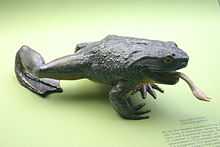Goliath frog
| Goliath frog | |
|---|---|
 | |
| Conservation status | |
| Scientific classification | |
| Kingdom: | Animalia |
| Phylum: | Chordata |
| Class: | Amphibia |
| Order: | Anura |
| Family: | Conrauidae |
| Genus: | Conraua |
| Species: | C. goliath |
| Binomial name | |
| Conraua goliath (Boulenger, 1906) | |
 | |
The goliath frog (Conraua goliath) is the largest extant anuran on Earth.[1] The largest known specimens can grow up to 32 cm (12.6 in) in length from snout to vent, and weighs up to 3.25 kg (7.17 lb). This animal has a relatively small habitat range, mainly in Cameroon and Equatorial Guinea. Its numbers are dwindling due to habitat destruction and its collection for consumption and the pet trade.
Description
In a sample of 15 individuals,[2] weights ranged between 600 and 3,250 g (1.32 and 7.17 lb), and snout-vent lengths were between 17 and 32 cm (6.7 and 12.6 in). Their eyes can be nearly 2.5 cm (0.98 in) in diameter. The conspicuous tympanum has a diameter of about 0.5 cm (0.20 in) and is separated from the eye by about 5 cm (2.0 in) in adults. The next largest extant anurans are the Cane toad, about a third smaller than the Goliath in the largest specimens, and the African bullfrog, which is just over half the size of the Goliath. Goliath frog eggs and tadpoles are about the same size as other frogs despite its very large adult form.
A lateral fold extends from the eye to the posterior portion of the tympanum. Toes are fully webbed, with large interdigital membranes extending down to the toe tips. The second toe is the longest. The skin on the dorsum and on top of the limbs is granular. Dorsal coloration is green sienna, while the abdomen and ventral part of the limbs are yellow/orange. They have acute hearing but no vocal sac, and also lack nuptial pads.
Habitat and distribution
The goliath frog is normally found in and near fast-flowing rivers with sandy bottoms in the Middle African countries of Cameroon and Equatorial Guinea.[2] These rivers are usually clear and highly oxygenated. Their actual range spans from the last 200 km (120 mi) of the Sanaga basin in Cameroon to the north to the last 50 km (31 mi) of the Benito River basin in Equatorial Guinea to the south. The river systems in which these frogs live are often found in dense, extremely humid areas with relatively high temperatures.
Ecology and behavior
Reproduction
Like most amphibians, water is vital for their reproduction. Because the goliath frog lacks a vocal sac, it does not produce mating calls, a behavior generally present in frogs and toads.[2] Males construct spawning and breeding areas alongside and within rivers by pushing rocks into semicircular patterns. The egg masses consist of several hundred eggs, approximately 3.5 mm each, attached to vegetation at the bottom of rivers.[3] Larval development takes between 85 and 95 days.
Diet
Goliath tadpoles are vegetarian and feed on a single aquatic plant, Dicraeia warmingii, found only near waterfalls and rapids, which may help explain their restricted range.[1] Adult goliath frogs feed on worms, and insects, such as dragonflies and locusts. They also eat smaller frogs, crabs, baby turtles, and young snakes.
Mortality
The goliath frog can live up to 15 years in the wild. In captivity, they can live up to 21 years. It is preyed upon by snakes, Nile crocodiles, and Nile monitors.
Conservation

Goliath frogs were considered to be a source of food in some parts of west Africa.[4] They were also highly exported to zoos and animal dealers to be sold as pets. Unfortunately, these frogs fail to thrive in captivity and almost never reproduce there. Due to their classification as an endangered species, the Equatorial Guinean government has declared that no more than 300 goliaths may be exported out of the country per year.[1] Some are captured and kept as pets.
References
- ↑ 1.0 1.1 1.2 "Goliath Frog". The American Museum of Natural History. 2007. Retrieved 2012-02-09.
- ↑ 2.0 2.1 2.2 Sabater-Pi, J. (1985). "Contribution to the biology of the Giant Frog (Conraua goliath, Boulenger)". Amphibia-Reptilia 6 (1): 143–153. doi:10.1163/156853885x00047.
- ↑ "True Frogs: Ranidae - Goaliath Frog(conraua Goliath): Species Accounts". Net Industries. 2008. Retrieved 2012-02-09.
- ↑ Amiet, J. (2004). Conraua goliath. 2006. IUCN Red List of Threatened Species. IUCN 2006. www.iucnredlist.org. Retrieved on 11 May 2006.
External links
![]() Data related to Conraua goliath at Wikispecies
Data related to Conraua goliath at Wikispecies
- Goliath frog at the Encyclopedia of Life
Media
- Photos of goliath frogs with people at Queensland Frog Society
- Conraua golaith at CalPhotos
![]() Media related to Conraua goliath at Wikimedia Commons
Media related to Conraua goliath at Wikimedia Commons
| |||||||||||||||||||||
